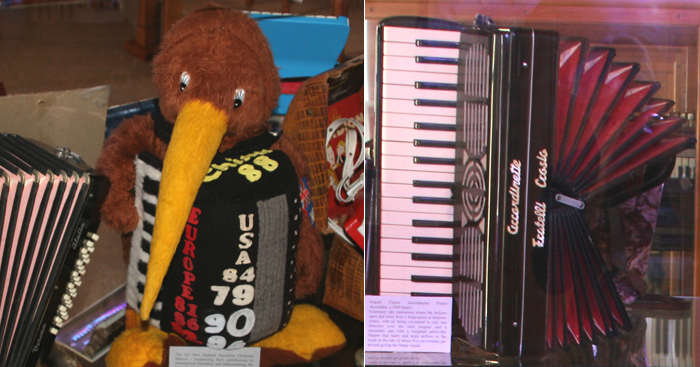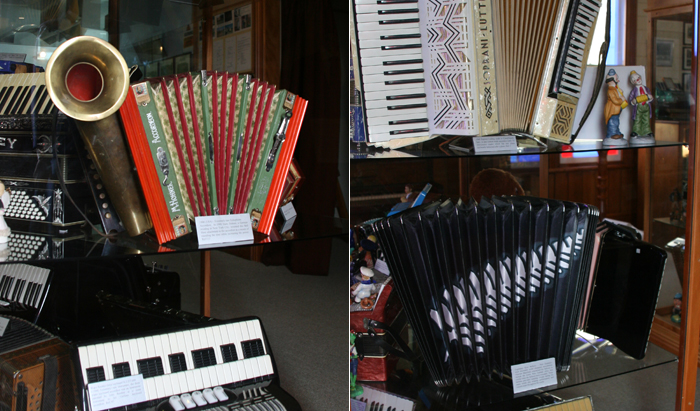|
The
Dargaville Museum (New Zealand) presents...
'Accordion Gems' by Kevin Friedrich
...A Master Collection
of Accordions through Time...
Aratapu
Library Purchased - June 2006
Dedication of the Accordion Gems Display - 3 December 2006
Aratapu
Library relocated to Harding Park - January 2007
Grand Opening of New Music Wing at the Dargaville Museum - 21
October 2007 at 1:00 PM
Launching of Accordion Gems Exhibit in Display Cabinets - 29
March 2009
|
|
|
The
'Accordion Gems' Collection |
The
Dargaville Museum presents 'Accordion Gems' by Kevin Friedrich...
A Master Collection of Accordions through Time...
The collection serves as the anchor display in the newly established
Music Room, the latest addition to the Dargaville Museum. In addition
to a variety of instruments form the accordion family, the display
includes original manuscripts, rare recordings, a 300 piece Accordion
Figurine Collection and other accordion related items. |
 |
|
Above
and below: some of the Accordion Gems instruments in their
hand crafted native timber cabinets |
 |
 |
Above left: The Air New Zealand Accordion Orchestra Kiwi Mascot from their 9 International Concert Tours.
Above right: The Fratelli Crosio - Accordinette Flutter Accordion. The bellows open and close from a hinge-point at bellows-center, and only a large handle where the bass section should have been. The shift did not provide unison or octave sound, but rather, accesses or denies an unusual fluttering of the acoustic reeds. Inside the 'Accordinette' are found single-tongue reeds, air being circulated by the bellows in only one direction over the tongues. The shift closes the internal air-supply-hole of a secondary pan with a weighted pallet-like flapper that starts and stops airflow to the reeds at the rate of about five movements per second. When engaged, the instrument sounds much like a harmonica. Unlike a normal 'reservoir' instrument, however, the bellows allow dynamic variations.
|
|
|
|
Above:
Ailsa Williams (Connecticut, USA) visiting the Accordion
Gems Display |
 |
|
Above:
some of the Accordion Gems instruments in their hand crafted
native timber cabinets |
 |
|
Above: examples of a Uniform Keyboard as well as Tanzbar
mechanical roll playing instrument |
 |
|
An example of an early Paolo Soprani e Figli instrument
from the late 1800's. Donated to Accordion Gems in loving
memory of the owner Gaetano Foti who was born on December
8, 1881 in Sicily, Italy and passed away on April 19th,
1961 in New York City, NY. The instrument was donated
by his grandson Thomas J. Mora of New York City.
The following manufacturing information is placed under
a glass panel on the front of the instrument:
Premiata Fabbrica di Armoniche
Comm. Paolo Soprani e Figli
Castelfidardo, Ancona, Italia
Riproduzione Vietata |
 |
|
Above:
Disc recording in center - This is a rare recording (which
plays inside to out) of a 37 year old Anthony Galla-Rini
(born January 18, 1904; died July 30, 2006) performing
the Premiere of his own Concerto No. 1 in G Minor,
on 15 November 1941, at the Fine Arts Auditorium in Oklahoma
City, with James Neilson conducting.
Small cylinder to the right: Pietro Frosini (1885-1951)
Accordion Solo, Sonata In C Major,
Edison Blue Amberol Cylinder record #3127, take 3, mold
10. Cylinder released April, 1917. |
 |
|
Graham
Romani was one of the leading composers, arrangers, writers
and historians on the accordion during his active career
in the United Kingdom. A friend, teacher and mentor of
the late Ben Emmett in Dargaville,
Graham Romani was also the teacher via TAPEspondence of
Joan Emmett (Brown).
Three of his Original Manuscripts are on display:
Little Dance Suite (composed 18 October 1961)
Valse Lyrique (composed 1940-1943)
Sonatina for Accordion (composed April 1947, revised December
1951 & December 1961) |
 |
 |
Above left: This Echophone Diatonic accordion was patented by Hans Hohner, a German citizen residing in New York City, on 15 September 1908. Always looking to invent new and useful improvements to accordions, Hans’s invention shown here provided the accordion with a novel and effective means for softening or rounding the tone, and at the same time increasing the power thereof. The sound waves entered the brass chamber, flowing towards the bulged sound horn. With the bulged horn, the waves were entrapped and deflected upwardly and emitted through the belled mouth. The patent was submitted by Hans Hohner in New York City on the 20 May 1908 and approved on the 15 September the same year. Below is the Three Piano Keyboard Patent No. 2,557,690, this extremely rare instrument was an instrument patented by John Reuther as a sister instrument to his Uniform keyboard accordion. Made for a friend of John Reuther’s, Frank Gaviani from St. Louis who had started studying music at an advanced age of 18 years old, the 3-deck keyboard was a one of a kind. It is a piano accordion with wide black keys and the first row duplicated by the third row. Frank did not want to alter the order fo the piano keys, but he wanted the advantage of the third row, and he wanted the advantage of the wide black keys. Because with the third row, he did not have to get in between the black keys, you could reach above them and interpose with the keys. Right: Legendary Kiwi Bellows: New Zealand's most decorated world champion accordionist Grayson Masefield customized his bellows to include the iconic new Zealand 'Silver Fern' visible when the bellows were extended. These bellows provided stunning visuals during his many world title winning performances and concert tours throughout the world.
|
 |
|
Tiger
Accordion: In the mid 60's, it was recognized that the
changing dynamic in music was heading towards Rock'n'Roll
and that it captured the interest of youngsters. Working
with Bill Palmer, Titano Accordions, under the Ernest Deffner Coop. designed and
introduced the Tiger Combo'Cordion. It was a line of compact
and colorful accordions in a choice of three Fiat car
colors - Fire, Sun and Blue Moon, featuring quint reed
(5th) treble tuning for "piercing lead or swinging
chords in audio colors to flip the crowds" according
to Hullabaloo magazine's description. Electronic pickups
provided a spectacular "biting" sound and a
voice microphone was fixed onto the top of the Combo'Cordion
ready for song. The instrument's keyboard angle (below)
followed the slanted grill so that flying fingers could
easily be seen by the audience. |
|
|
|
Featuring
popular characters such as Sesame Street's Ernie and Clown
figurines,
children are always fascinated by the little accordions
and characters playing them.
Pictured are Hayden, Caitlin, Hannah and Lilly admiring
the collection. |
 |
 |
|
The
Accordion Figurine Collection is displayed in both a
dedicated cabinet and throughout the Accordion Gems exhibition |
|
| The
Dargaville Accordion Collection |
Dargaville
was at one time, home to eight accordion bands conducted by several
different accordion teachers from Dargaville including Ben Emmett,
Doreen Emmett, Joan Emmett, Irene Langman, Frank Vilich and Mary
Passell.
In addition, many immigrants working in the Kauri and Gum Digging
industries as well as maritime workers used the accordions. The
instruments in this section, were used by residents of the Dargaville
area. |
 |
|
Several of the instruments played by various people from
the Dargaville area
|
|
| The
Puhoi Hotel Pub Collection |
|
In addition
to the Accordion Gem's display, the Dargaville Museum proudly
houses the unique collection of instruments from the Puhoi Hotel
Pub, highlighting some of the earliest accordionists in New
Zealand.
Among the early pioneers in New Zealand were settlers from Bohemia.
Many of them settled at Puhoi, just north of Auckland. There
were several early type button accordions brought out in the
first shipload of settlers in 1863 and until very recently,
the descendants of these early settlers still played button
accordions and entertained at the Puhoi Hotel Pub.
|
 |
|
Members
of the famed Puhoi Hotel Pub Band during the early 1900's
|
 |
|
The remaining instruments from Puhoi
|
Contact
for the Accordion Gems Exhibition: Kevin Friedrich

|
|
|
Copyright©
2012 Accordions Worldwide. All rights reserved.
|